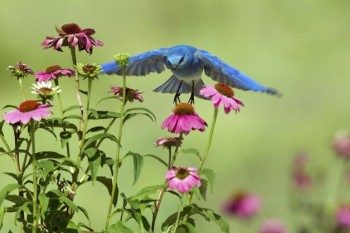click on links below to read full articles
http://shar.es/1brk5O
http://shar.es/1brAlI

Like most environmentally-friendly gardeners, I’ve long known that it’s better to cultivate native than nonnative plants. Adapted to local conditions, natives thrive better—and with less water and other expensive inputs such as fertilizer—than do most exotics. Natives also are less likely to invade ecosystems beyond the garden and, if they do, cause no problems because natural habitats are where these species come from. In addition, natives like milkweed provide essential food for favorite backyard visitors like monarch butterflies.

Because insects did not evolve with nonnative plants, most lack the ability to overcome the plants’ chemical defenses so cannot eat them. In the Mid-Atlantic region where I live, for example, native oaks provide food for 534 caterpillar species while gingko, a popular street tree from China, supports just one. Tallamy says birds such as chickadees and warblers rely specifically on caterpillars for 90 percent of their diet during the breeding season.
 Learn more about choosing and cultivating native plants, then turn your yard into aCertified Wildlife Habitat® site. This month only, Garden For Wildlife Month, NWF will plant a native tree in your honor when you certify your property.
Learn more about choosing and cultivating native plants, then turn your yard into aCertified Wildlife Habitat® site. This month only, Garden For Wildlife Month, NWF will plant a native tree in your honor when you certify your property.
--------------------------------------------------------------------------------------------------------------------------------------------------------
Plant a Native Bird Garden

more: http://www.birdsandblooms.com/birding/attracting-birds/plants-and-trees-that-attract-birds/plant-native-bird-garden/#ixzz3OxYrRKyK
http://shar.es/1brk5O
http://shar.es/1brAlI
Help Bugs—and Birds—By Growing Native Plants
from Wildlife Promise

A male northern cardinal feeds its mate a beetle larva in a Brandon, Mississippi, backyard. Insects, which rely on native plants, are critical food for birds, particularly during the breeding season. Photo by Paul Brown.
I didn’t appreciate just how important native plants are, however, until I began to work a story, “Urban Renewal,” published in the current issue of National Wildlife magazine. Reporting for the article, which describes various ways residents of cities and suburbs can help birds, I interviewed wildlife-gardening guru Doug Tallamy, an entomologist at the University of Delaware, and read his book, Bringing Nature Home: How You Can Sustain Wildlife with Native Plants.
Tallamy’s key message was that native plants are essential to producing the insects birds need, particularly during the breeding season. “Birds do not reproduce on berries and seeds,” he told me. “Ninety-six percent of terrestrial birds rear their young on insects.”

Carolina chickadees can feed their offspring up to 590 caterpillars a day. Photo by Patricia McCairen.
And they need a lot of caterpillars. Recently, Tallamy spent 16 days observing a Carolina chickadee nest in his Delaware backyard. He discovered that the birds fed their offspring between 300 and 590 caterpillars a day. Thechickadees needed 4,800 caterpillars to rear a single clutch of chicks.
“We’re used to thinking of the plants in our yards as decorations,” Tallamy says. It’s wonderful when plants are attractive, he adds, but if they’re exotics such as gingko, crape myrtle or European privet—all unpalatable to insects—they do not pass along the sun’s energy to birds and other wildlife. “You might as well install a statue,” Tallamy says.
--------------------------------------------------------------------------------------------------------------------------------------------------------
Plant a Native Bird Garden
The trees and flowers in a native bird garden will bring in more species than every before.

Steve and Dave MaslowskiConeflowers are a perfect fit in any native bird garden
Car
From a bird’s point of view, native plants are like Mom’s home cooking. They’re the tried-and-true foods that keep the birds coming back for more—the berries and seeds that bring in more bluebirds, orioles, goldfinches and a whole long list of other most-wanted species. Birds are already familiar with native plants, which make them a surefire attraction when their seeds or berries ripen. Rose-breasted grosbeaks, scarlet tanagers and about 150 other species recognize them at first sight and quickly descend to the waiting feast.
In terms of food offerings, seeds and berries are the most obvious to us, but birds are also attracted to something else--
Native plants hold a trump card-----caterpillars! Why should we care about caterpillars? Because they’re a prime target for p arent birds who have to satisfy a nest full of begging beaks. Birds will eat berries and seeds from nonnative plants, but caterpillars are super-finicky, and themselves feed mainly on all-American trees, shrubs and flowers that serve as their nurseries. The birds are more than happy to pluck these crawlers from host plants like red-twig dogwood, blueberries and spicebush.
more: http://www.birdsandblooms.com/birding/attracting-birds/plants-and-trees-that-attract-birds/plant-native-bird-garden/#ixzz3OxYrRKyK











No comments:
Post a Comment